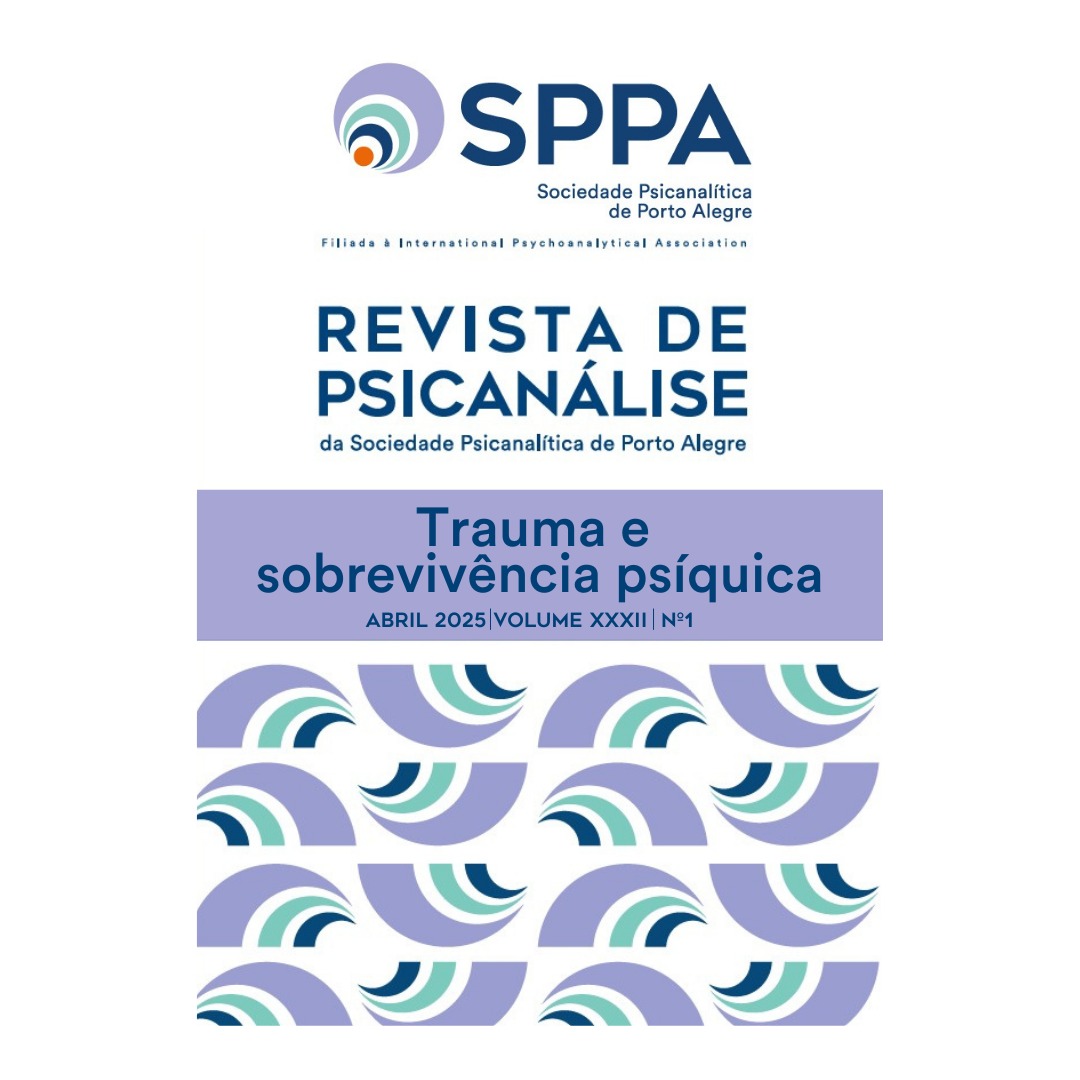Catástrofe y creatividad: de la fragmentación a la emergencia
da fragmentação à emergência
Palabras clave:
Trauma, Catástrofe, Verdad, Indiferenciación, Atomización, Defensas somáticasResumen
En este artículo, se sigue la línea de Ferenczi con respecto a lo primordial, explorando la búsqueda de la verdad, la cual, si exitosa, resultará tanto en una pérdida catastrófica como en una ganancia creativa. Al ingresar en lo primordial, Ferenczi nos conduce a experiencias de indiferenciación que nos hacen llegar a los orígenes del self. Según Ferenczi, la familiaridad con lo primordial nunca nos abandona, sino que permanece silenciosamente en nuestros cuerpos como telón de fondo para la verdad. Entramos en contacto con ese primordial en momentos de belleza que descubrimos en el arte, en la poesía, en la música o en la sexualidad. Verdad y belleza andan juntas y no se pueden separar. También podemos entrar en contacto con la verdad en momentos de pérdida. Desafortunadamente, la verdad puede ser atacada, y con consecuencias desastrosas, como sucedió en los años en los cuales las ideas de Ferenczi fueron desterradas de la discusión psicoanalítica. Los ataques contra la verdad son tan catastróficos como la verdad misma. Se presentarán viñetas clínicas acerca de los temas abordados.
Descargas
Citas
Bion, W. R. (1959). Attacks on linking. International Journal of Psycho-Analysis, 40, 308-315.
Bion, W. R. (1962a). A psycho-analytic theory of thinking. International Journal of Psycho-Analysis, 43, 306–310.
Bion, W. R. (1962b). Aprender da experiência. São Paulo: Blucher, 2021.
Bion, W. R. (1963). Elementos de psicanálise. Rio de Janeiro: Imago, 2004.
Bion, W. R. (1965). Transformações. Rio de Janeiro: Imago, 2004.
Bion, W. R. (1970). Atenção e interpretação. Rio de Janeiro: Imago, 2006.
Bion, W. R. (1971). Mudança catastrófica. Jornal de Psicanálise, 6(17), 18-26. (Trabalho original publicado em 1966).
Bleger, J. (1967). Symbiosis and ambiguity: a psychoanalytic study. (Editado por J. Churcher e Bleger; Trad. S. Rogers, L. Bleger e J. Churcher). London: Routledge, 2013.
Dupont, J. (Ed.). (1988). The clinical diary of Sándor Ferenczi, M. Balint & N. Z. Jackson (Trad.). Cambridge: Harvard University Press.
Eekhoff, J. K. (2019). Trauma and primitive mental states: an object relations perspective. London: Routledge.
Eekhoff, J. K. (2021a). Bion and primitive mental states: trauma and the symbiotic link. London: Routledge.
Eekhoff, J. K. (2021b). The black hole: alarm signal of catástrofe. In Bion and primitive mental states: trauma and the symbiotic link (pp.37-53). London: Routledge.
Eekhoff, J. K. (2022). Psychic equivalency as an aspect of symbiosis. In H. Levine & C. Moguillansky (Eds.), Psychoanalysis of the psychoanalytic frame revisited: a new look at Bleger’s classical work. London: Routledge.
Eekhoff, J. K. (no prelo). Bion’s emotional links: love, hate, and knowledge. London: Routledge.
Ferenczi, S. (1909). Introjection and transference. In First contributions to psychoanalysis (pp. 35-93). New York: Brunner/Mazel, 1980.
Ferenczi, S. (1910). Letter from Sándor Ferenczi to Sigmund Freud, October 12, 1910. In The correspondence of Sigmund Freud and Sándor Ferenczi: 1908-1914 (Vol. 1, pp. 224-226). Cambridge: Harvard University Press, 1993.
Ferenczi, S. (1912). Transitory symptom constructions during the analysis. In M. Balint (Ed.), First contributions to psychoanalysis (pp. 193-212). London: Karnac.
Ferenczi, S. (1913). Stages in the development of a sense of reality. In First contributions to psychoanalysis (pp. 213-239). London: Routledge.
Ferenczi, S. (1914). Letter from Sándor Ferenczi to Sigmund Freud, February 18, 1914. In The correspondence of Sigmund Freud and Sándor Ferenczi: 1908-1914 (Vol. 1, pp. 541-542). Cambridge: Harvard University Press, 1993.
Ferenczi, S. (1918). Letter from Sándor Ferenczi to Sigmund Freud, December 26, 1918. The correspondence of Sigmund Freud and Sándor Ferenczi: 1914-1919 (Vol. 2, pp. 319-320). Cambridge: Harvard University Press, 1996.
Ferenczi, S. (1926). The problem of acceptance of unpleasant ideas: advances in a sense of reality. In Further contributions to the theory and technique of psychoanalysis (pp. 366–379). New York: Bruner Mazel, 1980.
Ferenczi, S. (1928). The elasticity of psycho-analytical technique. In Final contributions to the problems and methods of psycho-analysis (pp. 87–101). London: Karnac, 1994.
Ferenczi, S. (1931). Letter from Sándor Ferenczi to Sigmund Freud, May 31, 1931. In The correspondence of Sigmund Freud and Sándor Ferenczi: 1920-1933 (Vol. 3, pp. 410-413). Cambridge: Harvard University Press, 2000.
Ferenczi, S. (1932a). 14 June 1932: permanent disturbance of object-libido. In J. Dupont (Ed.), M. Balint & N. Z. Jackson (Trad.), The clinical diary of Sándor Ferenczi (pp. 122–124). Cambridge: Harvard University Press, 1985.
Ferenczi, S. (1932b). 18 June 1932: a new stage in mutuality. In J. Dupont (Ed.), M. Balint & N. Z. Jackson (Trad.), The clinical diary of Sándor Ferenczi (pp. 129–131). Cambridge: Harvard University Press, 1985.
Ferenczi, S. (1933). Confusion of the tongues between the adults and the child (The language of tenderness and of passion). In Final contributions to the problems and methods of psycho-analysis (pp. 156–167). London: Karnac 1994.
Ferenczi, S. (1952). Symbolism. In First contributions to psychoanalysis (pp. 253-281). London: Routledge.
Ferenczi, S. (1988). The clinical diary of Sándor Ferenczi, J. Dupont (Ed.), M. Balint & N. Z. Jackson (Trad.). Cambridge: Harvard University Press.
Meltzer, D. & Williams, M. H. (1988). A apreensão do belo: o papel do conflito estético no desenvolvimento, na violência e na arte. Rio de Janeiro: Imago.
Winnicott, D. W. (1965). The maturational processes and the facilitating environment: studies in the theory of emotional development. In Psycho-analysis and the sense of guilt (1958), 64, 15-28.
Winnicott, D. W. (1986). Holding and interpretation: fragment of an analysis. The International Psycho-analytical library, 115,1-194.
Publicado
Cómo citar
Número
Sección
Licencia

Esta obra está bajo una licencia internacional Creative Commons Atribución-NoComercial-SinDerivadas 4.0.
Atribuo os direitos autorais que pertencem a mim, sobre o presente trabalho, à SPPA, que poderá utilizá-lo e publicá-lo pelos meios que julgar apropriados, inclusive na Internet ou em qualquer outro processamento de computador.
I attribute the copyrights that belong to me, on this work, to SPPA, which may use and publish it by the means it deems appropriate, including on the Internet or in any other computer processing.
Atribuyo los derechos de autor que me pertenecen, sobre este trabajo, a SPPA, que podrá utilizarlo y publicarlo por los medios que considere oportunos, incluso en Internet o en cualquier otro tratamiento informático.










